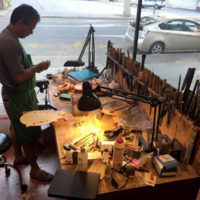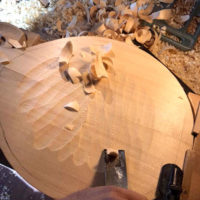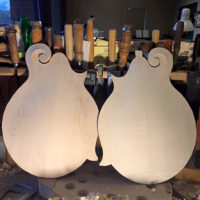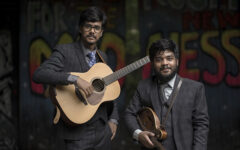
Gary Vessel is a renowned California Central Valley builder of all things violin and mandolin. He’s been at it for over forty years, and started as a teenager building violins. He attended the Violin Making School of America, and while he’d never say it, he ain’t a bad picker either.
Hi Gary, what is your family musical connection?
My father never told me to stay away from his vinyl collection or his turntable. I would routinely race home from school to listen to Roger Miller and Merle Haggard. This led to my interest in playing music and eventually building instruments. My father became interested in building a mandolin around the time I needed a better violin.
It was then that I met Boyd Paulson in San Mateo. He told me about the Violin Making School of America. That’s when I began thinking about becoming a builder. I was fifteen at the time. I had to decide between music school or violin making school, so I chose to make instruments. My older brother was getting pretty good on the banjo and we started to fall in love with the genre. It’s nice now to be able to blend my love of music and instruments. I’m lucky to have grown up in an environment that inspired my interest in music.
Did the rest of your family also play?
My father played guitar. My twin brother was the first to pick it up. My older brother started to learn the banjo when I was about ten or twelve. That’s when I started taking violin lessons. My uncles would play music when we’d get together. Every family gathering included music-making. Nobody was very good, but we all enjoyed it nevertheless. I think that’s the most important thing.
What instruments do you play?
I play the violin and mandolin. I can play guitar but almost never around people.
What were the first instruments you made?
At the violin making school, we had to make three violins at the beginning of the four-year course. My mother has one of those. Altogether, I had to make ten instruments to graduate, including two violas and a cello.
Who have been your biggest musical influences?
Merle Haggard is a distant relative. His grandfather and my great grandmother are first cousins. Growing up we would always try to play his music. I place him at the top of the list. Now, since I play a lot of mandolin, I’d have to say David Grisman.
What bands do/have you played in?
I currently play in Red Dog Ash and California Zephyr.
Red Dog Ash has played some fairly high-profile festivals, haven’t they?
Red Dog Ash has played some great festivals and venues. We’ve done CBA Father’s Day, Susanville, Havasu, the Good Old Fashioned, Flagstaff, and the band competition at RockyGrass. I’m very proud of the bluegrass series we ran locally for a handful of years at a very nice old theatre in Newman, the West Side Theatre. We would host the first set, and that would serve as the opener for a guest band, mostly other Northern California bluegrass bands. It was a very fine series that I hope to bring back on a smaller scale next fall.
California Zephyr has been around for almost 50 years. They really had their heyday in the late ’70s and early ’80s. A great bunch of old guys.
Faux Renwah at the Newman West side Theatre
Red Dog Ash performs a lot of original material. Do you compose?
I’ve written a few of our songs, and I hold the distinction of being the only band member to have written a song that was singled out by a concertgoer to NOT play. It was a murder ballad that struck close to home. I also wrote a very personal song about my grandfather that appeared to me in two dreams several months apart. I have a hard time singing it sometimes.
The Abolitionist John Brown by Red Dog Ash
When did you start building instruments?
When I was 17.
You’re a fine musician. What made you decide to pursue building instruments versus playing them professionally?
I was accepted to attend the Violin Making School of America and a music school in Levelland, Texas in the same week. I had to make a decision, and I think I chose the right one. I’m better suited to making messes and stressing over a piece of wood and varnish than I am stressing about a performance.
What instruments do you make and which are the most fun?
I build orchestral instruments and mandolin family instruments. I love building them all, but the violin is king. F-model mandolins are always striking and beautiful, but building a really great violin is incredibly challenging. The demands on a violin are greater.
Can you expand on that?
The demands on a violin are greater than any other instrument. I think that’s why they’re more demanding to build. A mandolin has more limited use. Violin is king – it’s the most prestigious of the musical instruments and the most coveted. They’re also extremely expensive. When someone spends very serious money, the product has to be exceptionally fine. It’s an incredibly demanding part of building an orchestral instrument. I also think that the tonal nuances of an instrument without frets are much broader. A quality violin has an almost infinite degree of tonal possibilities. Great players want as big a palette as possible. That’s only possible if the violin is well made and well set up.
What artists play your instruments?
I have many instruments in orchestras all over, including the Boston Symphony and the Lyric Opera Orchestra in Chicago. I also have Instruments in orchestras in Israel and Denmark. Maya Beiser has been using one of my cellos since 1991. She’s toured the world many times over and has dozens of recordings with my cello. Patrick Sauber has a mandolin and a mandola of mine, and he can be seen and heard in many bands in many places. My greatest feather in the cap is the violin that I gifted to Merle Haggard. His bus driver, Dean Row, told me two years later that Merle kept my violin in his recording studio.
Nathan Livers on Mandolin Monday’s singing on a Vessel Mandolin
How has your business changed since the pandemic?
I’m working harder than I ever have had to. But, strangely, repairs have been coming in more than before. I’m very grateful for that.
How many instruments are you able to complete a year?
I’ve been averaging four per year for several years now.
What are some of your biggest struggles and how did you overcome them?
The constant demand to get better at your craft. There are so many great builders today. The only real way to overcome it is to get involved with groups of other builders to compare notes and struggles. This craft is humbling, but to feel like you’re not the only one is very helpful.
You’re known for making exact replicas or bench copies of Gibson Lloyd Loar era mandolins. Tell us how you came to do that.
Violin making has been full of copyists since the late 17th century. All violin makers are copying something. When I made my first mandolin it just made sense to make a Loar copy. It’s an incredible way to learn what to do, much like an art student sitting in the Louvre copying a great work hanging on the wall. Every instrument presents challenges during the building process, but a full and complete understanding of how they’re supposed to look and feel helps figure out the challenges. Making exact copies speeds up the learning curve.
Patrick Sauber Test Driving a Vessel Loar Copy Mandola
What led you to put labels with Lloyd Loar signatures in some of them?
I’ve gotten a lot of opposition from some people who disagree with my label copies. My feeling is that the entire instrument is a statement of my time spent studying these instruments. It’s also somewhat of a tongue-in-cheek kind of joke. The reason people buy replica Loar mandolins is for the possibility of fooling somebody, at least short term. The label just helps with that chuckle, the punch line.
Have any been resold as the real thing?
No. There are a couple of things that are just impossible to do exactly how it was done in a factory.
What’s the key to making an instrument sound great before it’s been broken in?
The best way to start is by using good materials and models. I’ve been studying instruments for over 40 years. It’s an amalgam of those studies and failures.
Give us an example of good materials that you use.
Good materials can grow anywhere, and so can bad materials. I’ve had the good fortune of having some of the most knowledgeable people around me when identifying wood, and learning how to judge fine tonewood. The maple that I selected while living in Europe is specifically from Bosnia. The spruces from Europe that I’ve used come from the Alps, and some of it comes from the forests in Northern Italy. The United States is blessed to have many varieties of very fine tonewoods. Engelmann spruce that grows here and in Canada is exceptional tonewood. The maple that I get from the Midwest is some of the most beautiful stuff I’ve ever seen.
How do you choose the wood?
While I was working in Germany, I had an opportunity to hand select many of the billets that I’ve been using for my entire career. The same is true for some of the spruce that I use. However, I’ve also been using some North American spruces for my orchestral instruments, including Engelmann spruce.
For mandolins, I’ve been using maple that comes from the Midwest of the United States. I’ve also been using red spruce from New York state that I hand selected. The Engelmann spruce that I use for my mandolins comes from British Columbia, and I’ve also hand selected that.
What interests you when you are not playing music or making instruments?
A fine cigar, bird watching, listening to my daughters’ laugh is a real joy. They’re not even aware how often I sit and smile to myself as they’re oblivious to me.
Do different instruments sound better for specific genres?
Difficult to say, but I think we each get a sound in our ear and we gravitate to that. Sometimes that’s not a good thing. I love a tone that feels like it encompasses the listener. I don’t like the sound of most fiddle players. There shouldn’t be a difference between a classical violinist’s tone and a fiddle player’s tone, but there is. Mostly that comes from fiddle players using cheap strings and instruments that aren’t very good. It can be frustrating at times.
A good tone is a good tone regardless of genre, at least in my mind. I think Stéfane Grappelli is a perfect example. His tone was as good as Isaac Stern’s yet he played jazz. As great as Kenny Baker was, his tone at times wasn’t something I’d try to copy. His playing was unmatched, but I wish he would have played a better sounding instrument. I’m sure I’ll get crucified for that sacrilegious statement, but listen to Stern, Grappelli, and Baker one right after the other. Ignore the genre and listen to the tone.
Are your customers more classical or bluegrass players?
I’m fortunate that I’m able to work with both orchestral players and bluegrass players. Those are my two biggest musical loves, and I know those two genres the best. I’d say it’s split about 50/50.
What questions would you ask of your favorite artist or inspiration?
I like hearing about their struggles. As great as we see them, they’re still only human. I think hearing about their hard times gives us all hope.
What tunes do you enjoy playing?
The third movement of the Bach A minor violin concerto, and First Day in Town or Jerusalem Ridge.
What artists and luthiers do you follow?
Grisman, Los Lobos, Tom Waits, Monteleone, Gilchrist, the Testore family, and Andrew Ryan.
Do you do any musical instruction?
I’ve had a couple of mandolin students over the last ten years but I don’t have any currently.
Any final thoughts or things you want to share with the readers?
Go practice!
Right on. Thanks so much, Gary.
Thank you.
Red Dog – Cathedral, about the life of Ash John Muir













